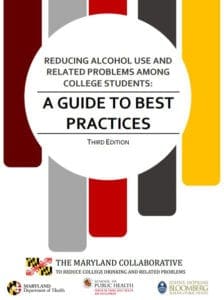A Guide to Best Practices
 This is the third edition of A Guide to Best Practices. The Guide synthesizes the existing research on interventions that are and are not effective. Research studies during recent decades have demonstrated the comparative effectiveness of different approaches to reduce college student drinking. Some approaches, such as simply providing information to students about the risks of alcohol consumption, are not effective in changing behavior.
This is the third edition of A Guide to Best Practices. The Guide synthesizes the existing research on interventions that are and are not effective. Research studies during recent decades have demonstrated the comparative effectiveness of different approaches to reduce college student drinking. Some approaches, such as simply providing information to students about the risks of alcohol consumption, are not effective in changing behavior.
This Guide describes the two major categories of interventions that seem to have the most promise. First, providing intensive personalized feedback and monitoring drinking patterns over time can help an individual to recognize the existence of a problem and modify his/her behavior. Second, on a more macro-level, changes in the environment to reduce the availability of alcohol as well as youth access to it are clearly effective ways to decrease excessive alcohol use and associated problems.
This Guide includes a detailed description of various strategies, a summary of the research supporting or refuting their effectiveness, and tips for implementation. By clearly and concisely summarizing the evidence regarding which approaches have been found to be effective or promising, and which have not, college administrators and community stakeholders can have a better idea of how to allocate resources more effectively.
Download the PDFA Guide to Best Practices
 This is the third edition of A Guide to Best Practices. The Guide synthesizes the existing research on interventions that are and are not effective. Research studies during recent decades have demonstrated the comparative effectiveness of different approaches to reduce college student drinking. Some approaches, such as simply providing information to students about the risks of alcohol consumption, are not effective in changing behavior.
This is the third edition of A Guide to Best Practices. The Guide synthesizes the existing research on interventions that are and are not effective. Research studies during recent decades have demonstrated the comparative effectiveness of different approaches to reduce college student drinking. Some approaches, such as simply providing information to students about the risks of alcohol consumption, are not effective in changing behavior.
This Guide describes the two major categories of interventions that seem to have the most promise. First, providing intensive personalized feedback and monitoring drinking patterns over time can help an individual to recognize the existence of a problem and modify his/her behavior. Second, on a more macro-level, changes in the environment to reduce the availability of alcohol as well as youth access to it are clearly effective ways to decrease excessive alcohol use and associated problems.
This Guide includes a detailed description of various strategies, a summary of the research supporting or refuting their effectiveness, and tips for implementation. By clearly and concisely summarizing the evidence regarding which approaches have been found to be effective or promising, and which have not, college administrators and community stakeholders can have a better idea of how to allocate resources more effectively.
Download the PDF